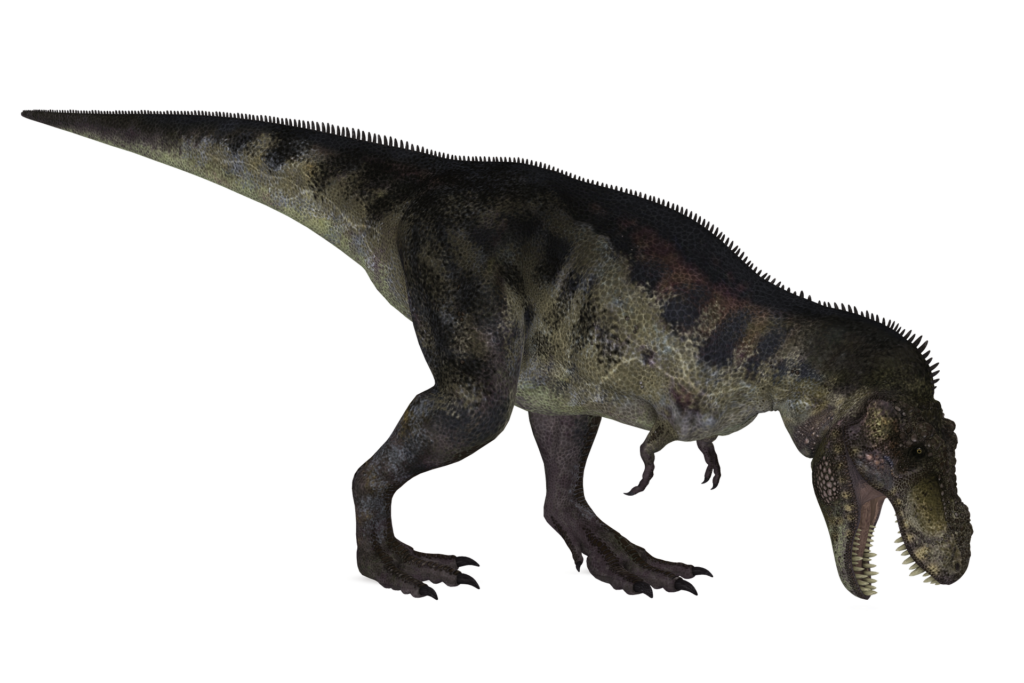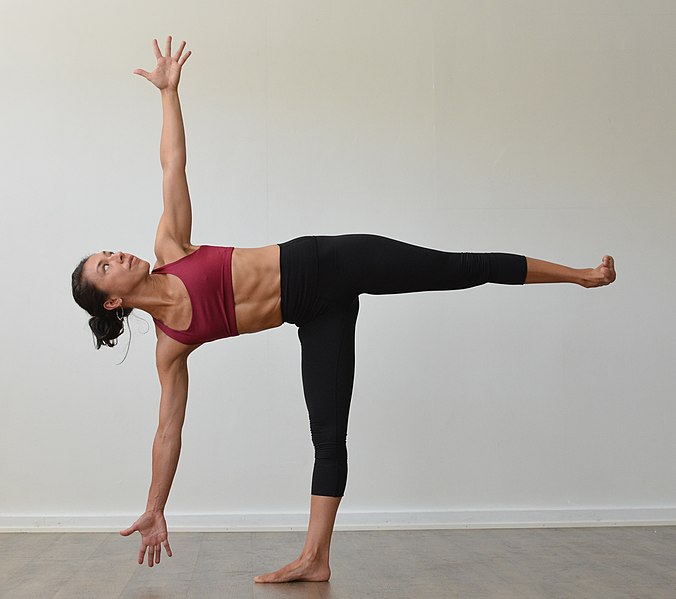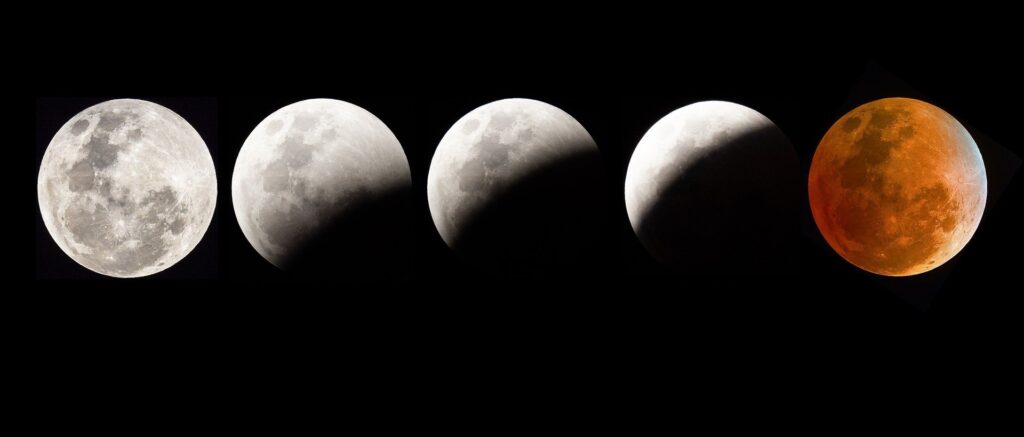Half moon pose is one of those yoga postures that I struggled with and hated for years until I finally realized two things:
- I was doing it wrong.
- I have really short, T-rex arms, and that’s okay.

Once a yoga instructor gently pointed out how totally off my form was and showed me how to fix it, I fell in love with the pose. It’s still challenging, and I still wobble, but I enjoy the journey now instead of loathing it.
Today, I want to be that yoga instructor who helps you learn to love half-moon. It doesn’t have to be perfect, and it doesn’t have to be your favorite, but I think that it’s an important pose to dive into more deeply.
So, let’s get started!
Half Moon Yoga Pose 101
In this section, I’m going to give you an overview of the pose itself. I’ll talk about the Sanskrit name (so that you know it if you hear it in a yoga class later), what type of pose it is, and what it looks like.
What it is
You may also hear this pose referred to as “Ardha chandrasana,” which sounds complicated and intimidating.
First, let’s talk pronunciation. Say, “ard-HA shan-DRAH-sah-nah.” Ardha means “half,” and Chandra means “moon.” Asana is simply the word for “pose” or “posture,” so you’ll see it in almost every Sanskrit yoga pose name.
The pose itself is a standing balance that, in its full form, is said to resemble a half-moon. Personally, I usually feel more like a wobbly banking airplane, but that doesn’t sound nearly as elegant as a graceful half moon, does it?
What it looks like

Because this is a hip-opening standing balance, it usually comes after triangle pose or at the end of a sequence that moves you through warrior II and III.
When you successfully manage the pose, it truly makes you feel powerful. If you believe in the concepts of chakras and natural energies, this likely comes as no surprise. Half-moon is said to be a kind of “meeting point” between the grounded, balanced energy of the moon and the fiery, forceful energy of the sun. When they meet, they’re said to create an energy that’s greater than the sum of their individual parts.
This is because you are simultaneously grounding yourself through your standing leg while extending outward with your lifted leg and allowing your chest and pelvis to be open. There are a lot of moving parts, but it’s completely doable!
I’m going to give you a brief step-by-step outline of how to get into the pose, and I’ll also link a short video tutorial so that you can see it in action.
The Basics of Ardha Chandrasana
- Root your standing leg firmly into your mat. Be sure that you’re standing on your whole foot (rather than shifting your weight to the outer or inner edges of your foot). Try to press your big toe and your heel into the mat, and don’t be afraid to take a minute to experiment with shifting your weight around on your standing leg until you feel like your weight is evenly distributed.
- Tilt forward, and place your hands on either side of your toes. Try to create a straight line from your shoulder to your wrist. Be sure that you can create a diagonal line from your standing leg’s pinky toe to your bottom hand’s fingertips. This will help you keep a more stable alignment.
- Lift the opposite leg straight back. Try to create a strong, straight line from your glute through the sole of your flexed foot. It’s natural to try to rest your weight into your hands, but use the power of your quads and core to only rest lightly on your hands. Focus on grounding straight through your standing leg and back through your lifted leg.
- Begin to lift your chest and rotate through your lifted side. Go slowly, and as you lift your arm upward, try to stack your hips and shoulders in a straight line. This part can be difficult, but remember to keep breathing and let your movements flow with your breaths.
- At the peak of the pose, you should feel strong and rooted through your standing leg. Your lifted leg should be actively pressing outward, your foot flexed, and your chest, torso, and pelvis should be opened toward the wall. Your lifted arm should be energetically reaching up toward the ceiling, and your gaze should be either facing the wall or lifted to your reaching hand.
If you’re a visual learner and would prefer to watch how this pose is done, this quick tutorial does a good job of demonstrating how it should look!
Common Challenges and Pose Variations
This is the type of pose that can be completely changed just by making very small adjustments. You might feel like it’s too challenging for you, but the reality could be that you just need to make one or two minor changes to your posture. (This was my problem!)

3 Common Problems With Half Moon
- You’re falling forward. If you feel like you’re falling forward when you raise your opposite leg, or you struggle to find balance in general, you may need blocks. Your back should form a tabletop when you tilt forward and place your hands on the ground, so if you’re angled too far forward (aka you have short arms like me), experiment with different block heights under your hands until you find one that allows you to maintain a flat back.
- You’re tipping to the side. Whether you’re falling backward or forward when you try to open up, the problem usually stems from accidentally aligning yourself at an angle. Be sure that your standing leg toes are all pointed forward, your lifted leg toes are flexed strongly, and your hips aren’t cocked outward or to the side. Draw yourself up into the straightest line possible as you move through this pose, and keep your muscles activated. You’ll wobble much less!
- You can’t maintain an open posture. It’s difficult to remain stable once you’ve opened the pose to face the wall. Because so much of mastering this part relies on being able to feel when your posture is correct, I strongly recommend practicing against a wall. The firm stability of a wall behind you will allow you to properly stack your hips and shoulders, and it will help you feel how to energetically lift yourself into alignment without fear of falling over.
3 Easy Modifications For a Comfortable Half Moon
- Use blocks under your hands. Many of us have longer legs than arms, and this can make most yoga poses unnecessarily frustrating. Using blocks isn’t a sign of weakness or failure; it’s simply necessary for a safe and comfortable practice! Acknowledging your physical limitations honors your body.
- Use the wall for support. Constant wobbling can interfere with having a positive, refreshing practice. While you should always strive to “stay with your wobbles” and be okay with them, it can be beneficial to do this pose with your back against a wall for support and stability. You’ll still be able to work on your form and balance, but you won’t have the frustration of having to repeatedly start the pose over.
- Practice a related pose. If your struggles come from revolving open into half moon, then practice airplane pose or warrior III instead. Rather than opening up to the wall, you simply work on maintaining your balance with your gaze down.
Another variation is to flow through half moon form while kneeling on the ground. This allows you to feel the openness, energy, and alignment of half moon, but you have a more grounded and stable base to work from.
What Are the Benefits of Half Moon Pose?
In general, all yoga poses can help you become stronger, and half moon is no exception.
There are several half moon pose benefits for both your mind and body!
The Physical Benefits
First, it allows you to work on your overall coordination. Balancing half moon helps you focus on how your body moves through space. I don’t know about you, but I always feel like I could be more graceful and coordinated.
Second, since you’re standing on one leg at a time, it helps you strengthen and activate each leg equally. When you perform yoga poses or other exercises that let you stand on both legs, it can be difficult to work them evenly. This particular pose also allows you to strengthen your ankles, hamstrings, glutes, and knees.
Third, whether you fully revolve or not, you are activating your core muscles and opening up your chest and shoulders. A strong core is the foundation of most yoga poses, and the more you work on this, the easier your practice will become.
“Yogic practices enhance muscular strength and flexibility, promote and improve respiratory and cardiovascular function…and enhance overall well-being and quality of life.” – Exploring the Therapeutic Effects of Yoga (doi 10.4103/0973-6131.85485)
The Mental Benefits
It’s easy to overlook how much yoga can contribute to positive mental health! Exercise in general is good for your mind, but yoga has a unique set of mental benefits.
I believe that the most important aspect of practicing yoga (particularly with challenging poses like half moon) is that it gives you a safe space to practice self-acceptance. Even the most skilled yogis have room for improvement, but they never let that get in the way of their practice. Learning to accept yourself exactly as you are (modifications, wobbles, and all) is a huge act of self-care, and every yoga pose is a fresh opportunity to learn to love yourself.
Balance postures also give you a unique opportunity to connect with your breathing and focus. A common mistake that everyone makes is to hold their breath while concentrating on a pose, but this actually interrupts the flow and makes it much harder to succeed in the posture. Slowing down and moving your body with the flow of your breath is a skill that must be practiced. Once you learn to focus on your breath and connect with your body, you will likely find that you can utilize this skill in other aspects of your life as well.

Final Thoughts
Ardha chandrasana is a beautiful, challenging pose. Whether you choose modifications to make it easier, or you prefer to amp up the intensity with more difficult half moon variations, this is a posture that can test your mind as well as your entire body.
In future posts, I’ll explore half moon pose more in-depth with topics like modifications for physical limitations, half moon pose variations to increase the challenge, and more nuanced instructions for polishing your form.
Do you have questions I haven’t answered or tips you’d like to share? Leave them in the comments below!